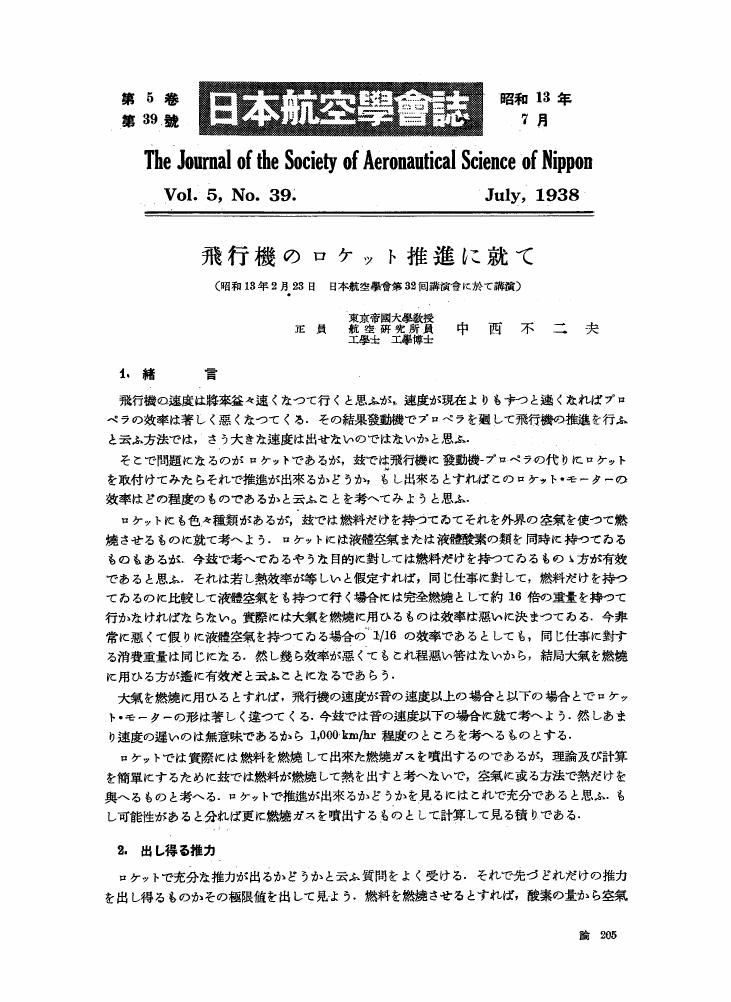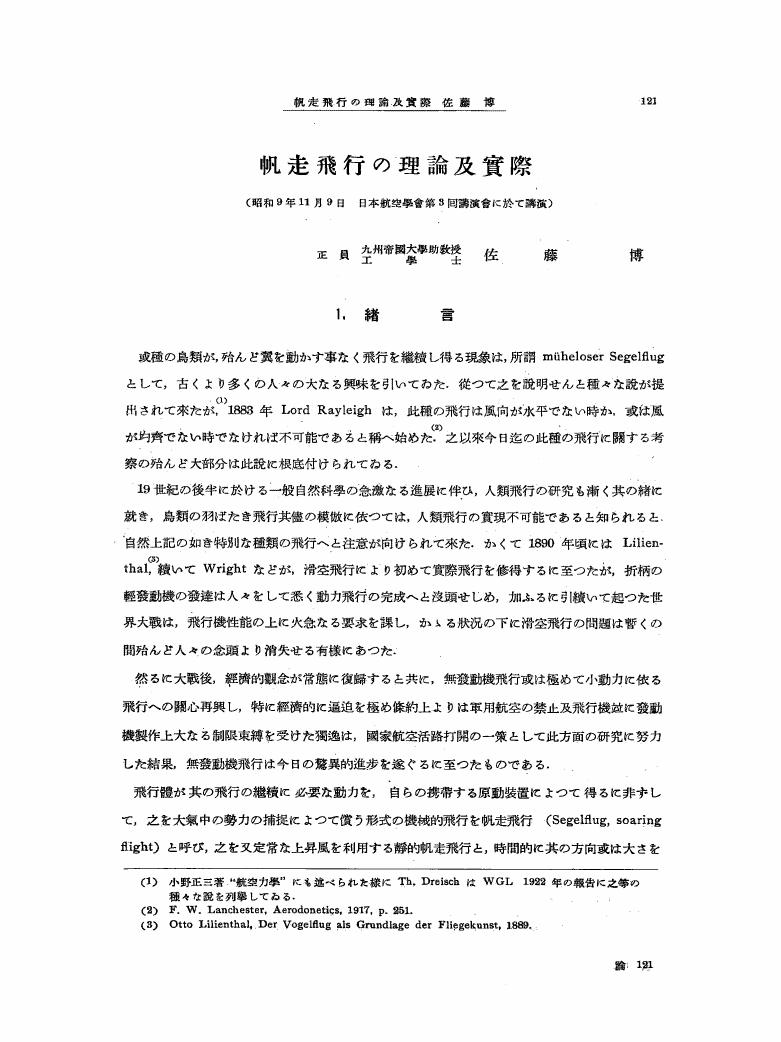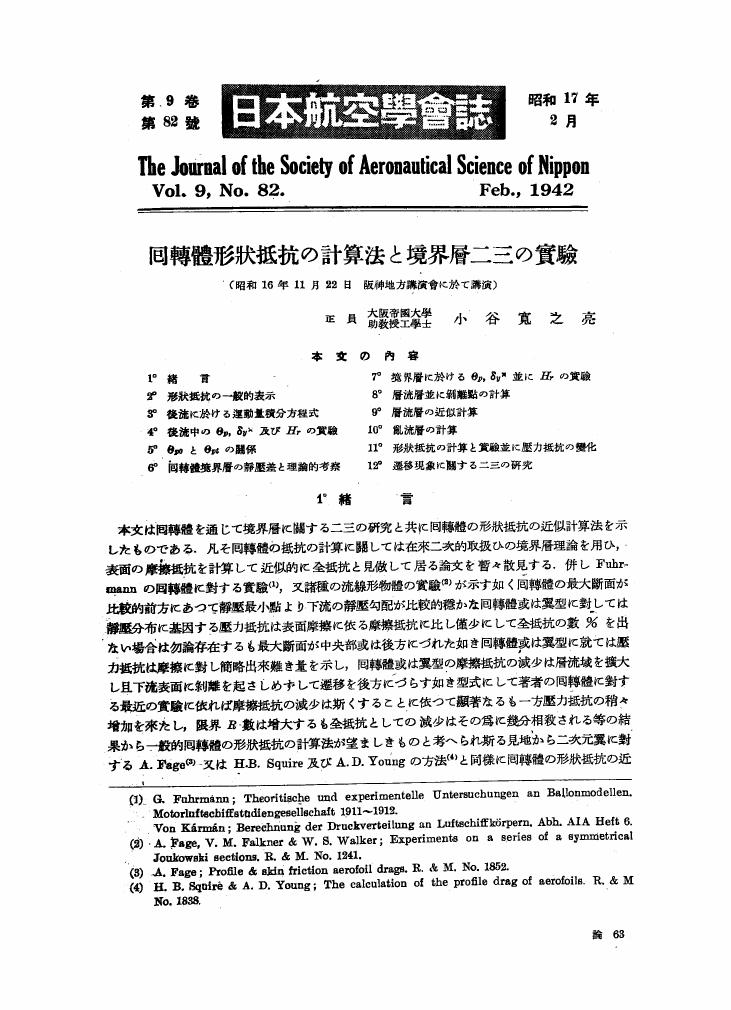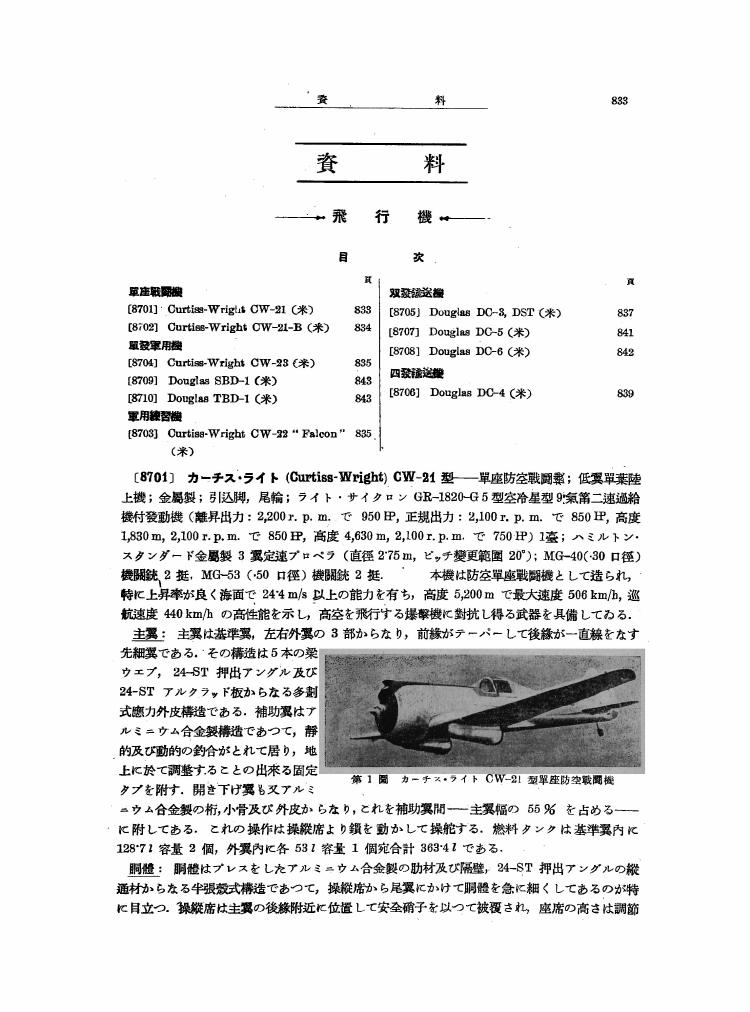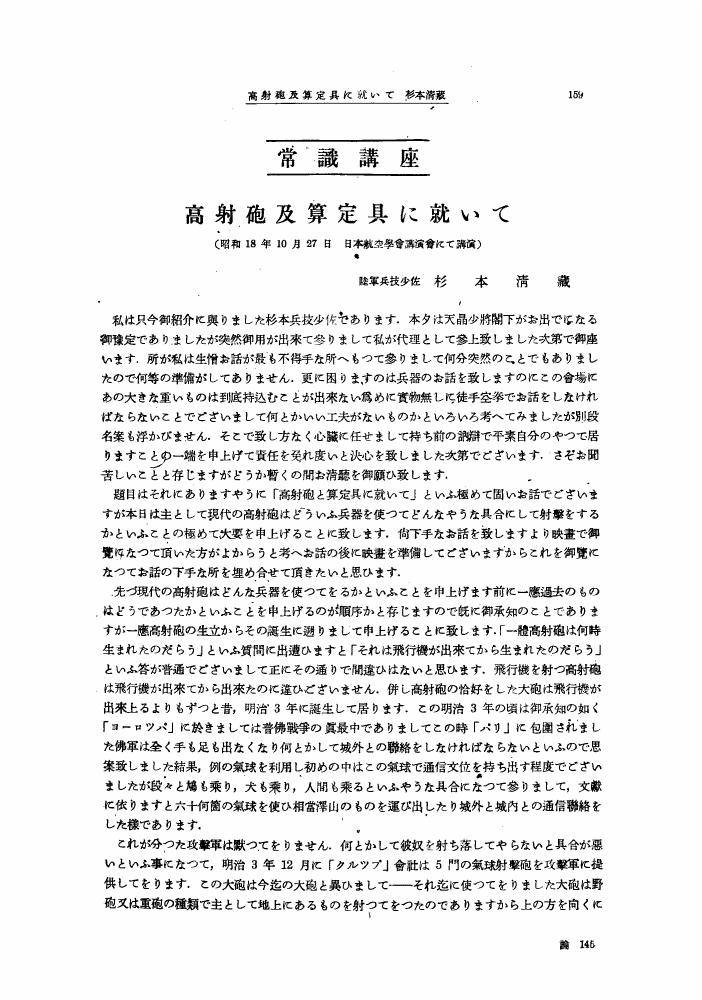21 0 0 0 OA 飛行機のロケット推進に就て
- 著者
- 中西 不二夫
- 出版者
- 一般社団法人 日本航空宇宙学会
- 雑誌
- 日本航空學會誌 (ISSN:18835422)
- 巻号頁・発行日
- vol.5, no.39, pp.669-678, 1938-07-05 (Released:2009-07-09)
13 0 0 0 OA 記録,統計,時報
- 著者
- 木村 秀政 高坂 憲三
- 出版者
- 一般社団法人 日本航空宇宙学会
- 雑誌
- 日本航空學會誌 (ISSN:18835422)
- 巻号頁・発行日
- vol.6, no.51, pp.812-819, 1939-07-05 (Released:2009-07-09)
5 0 0 0 OA 單葉機の主翼に前進或は後退角を附けたる時の揚力及抗力に及ぼす影響に就て
- 著者
- 小谷 寛之亮
- 出版者
- 一般社団法人 日本航空宇宙学会
- 雑誌
- 日本航空學會誌 (ISSN:18835422)
- 巻号頁・発行日
- vol.2, no.3, pp.23-37, 1935-01-04 (Released:2009-07-09)
Wenn man einmal einen positiven oder negativen Pfeinform dem TragFlügel gegeben hatte, so wurde es sich hauptsachlich um die Stabilitat handeln. Der EinFlüss des Winkels auf den Auftrieb und Widerstand, mit Ausnahme von einigen besonderen Fallen, wurde noch nicht geklart.Also versuchte ich eine approximative Berechnung zu vervollstandigen, um die wegen des mit beiden Winkeln versehenen Flügels entstehende, allgemeine Tendenz von Auftrieb und Widerstand klar zu machen, indem ich einen Versuch an den rechtwinkeligen, mit einer positiven oder negativen Pfeinform versehenen Flügel von Clark-Y Profil, in einem Einmeterkanal machte.Nach meiner Betrachtung wird die Verteilung der Zirkulation unbedingt um die Gestalt des ebenen Flügels bei der Berechnung sich handeln, weil er mit einer positiven oder negativen Pfeinform versehen ist. Folglich berucksichtigte ich die in der Flügelsbreiterichtung sowohl als in der Flügelssehnerichtung entstehende Verteilung und ich bemuhte mich daraus eine Berechnungsmethode zu verwirklichen.
4 0 0 0 OA 任意翼型の理論
- 著者
- 今井 功
- 出版者
- 一般社団法人 日本航空宇宙学会
- 雑誌
- 日本航空學會誌 (ISSN:18835422)
- 巻号頁・発行日
- vol.9, no.88, pp.865-875, 1942-08-05 (Released:2009-07-09)
3 0 0 0 OA 航空評議会材料規格に就て
- 著者
- 岩本 周平
- 出版者
- 一般社団法人 日本航空宇宙学会
- 雑誌
- 日本航空學會誌 (ISSN:18835422)
- 巻号頁・発行日
- vol.5, no.41, pp.902-911, 1938-09-05 (Released:2009-07-09)
3 0 0 0 OA 滯獨雜感(その2)
- 著者
- 辻 猛三
- 出版者
- 一般社団法人 日本航空宇宙学会
- 雑誌
- 日本航空學會誌 (ISSN:18835422)
- 巻号頁・発行日
- vol.9, no.89, pp.1119-1124, 1942-09-05 (Released:2009-07-09)
3 0 0 0 OA 滯獨雜感(その4)
- 著者
- 辻 猛三
- 出版者
- 一般社団法人 日本航空宇宙学会
- 雑誌
- 日本航空學會誌 (ISSN:18835422)
- 巻号頁・発行日
- vol.9, no.91, pp.1305-1312, 1942-11-05 (Released:2009-07-09)
2 0 0 0 OA 帆走飛行の理論及實際
- 著者
- 佐藤 博
- 出版者
- 一般社団法人 日本航空宇宙学会
- 雑誌
- 日本航空學會誌 (ISSN:18835422)
- 巻号頁・発行日
- vol.2, no.3, pp.121-136, 1935-01-04 (Released:2009-07-09)
2 0 0 0 OA 主翼の応力計算法に就て
- 著者
- 内藤 子生 高田 守正
- 出版者
- 一般社団法人 日本航空宇宙学会
- 雑誌
- 日本航空學會誌 (ISSN:18835422)
- 巻号頁・発行日
- vol.5, no.44, pp.1205-1224, 1938-12-05 (Released:2009-07-09)
The stress analysis of the wing is now in general calculated by the idea of so called "elastic axis". But the idea is based on the assumption that the metal covered wing is so rigid to torsion that any torque offers to the wing no torsional deflection, and that the torque offers no stress to flangess. Therefore it may be easily supposed that the former idea may fail in the case of large torque. The present paper discribes a rational and rigorous method of stress analysis for wings which was developed and successfully applied by the authors in desigh of an aeroplane. The principle of the present method is based on the well known fact that the total deflection of a beam is the sum of the bending deflection and the shear deflection, considering the whole structure as statically indeterminate. Applying the principle of minimum strain energy, the authors calculated both the energy of bending and the energy of shear as shown in the eqn. (13) of illustrative problem. So the paper notes to the idea of "Shear Lag", and treats it analytically. Fig.3 is the illustrative problem. Flanges are considered to take fiber stress only. Webs, skins and ribs are considered to take shear stress only, recieving no fiber stress in X direction. Shear stresses in webs and skins between ribs are considered constant, changing only at ribs. Balance of the forces are expressed in six components, eqns (1)→(6). The idea of Fig.4 leads to eqs (7)→(10). They may be reduced to the relation (11). Statics gives no farther relation, q is indeterminate and must be solved by the principle of mininum strain energy. Total strain energy may be expresseed by (13), equation for q by (14), required solution for q by (15), and the other unknown by (11) & (15). Thus the inter-action of ribs and skins to both spars are easily calculated, which should be compared with the theory of Paul Kuhn, treating the rib action in the wing of wooden spar (N.A.C.A. Tech. Rep. No 508, 1935). Chapter 5 and 6 are the formula which were practically applied by the authors in the design of a seaplane. In the appendix (the last chapter), phisical meaning of expression (15) are developed. When L=∞ or G=∞, exp. (15) is reduced to the idea of "elastic axis, " in which the first term is for bending and the recond term is for torsion. When tv=tL=0, exp. (5) is reduced to the formnla for fabric covered wing. Thus it is concluded that the idea of "elastic axis" can be correctly applied only for the region far away from wing root and not for the region near the wing root, where the present method is varlid and beneficient.
2 0 0 0 OA 新飛行機
- 出版者
- 一般社団法人 日本航空宇宙学会
- 雑誌
- 日本航空學會誌 (ISSN:18835422)
- 巻号頁・発行日
- vol.8, no.80, pp.1319-1326, 1941-12-05 (Released:2009-07-09)
2 0 0 0 OA 航空神經症
- 著者
- 田中 肥後太郎
- 出版者
- 一般社団法人 日本航空宇宙学会
- 雑誌
- 日本航空學會誌 (ISSN:18835422)
- 巻号頁・発行日
- vol.2, no.7, pp.975-988, 1935-09-07 (Released:2009-07-09)
- 参考文献数
- 7
Aeroneurosen sind nach täglichen langen Flugen und mehrmalig wiederholten höhen oder häftigen acrobatischen Flügen semichronisch auslosende psycho-neurasthenischee Symptomenkomplexe. Als Hauptsymptomen sind allgemeine Mattigkeit, Schlafsucht und verschiedene neuropsyasthenischen Symptomenkomplexe gegeben. Author teilte nach Schneider's Idee die Symptomenkomplexe in vier Gruppen und klassifizierte die begegneten Fällen in die Gruppen: 1. Neuropsyasthenische Form. 2. Herz-Gefässstörungs Form. 3. Magen-Darmstörungs Form. 4. Gleichgewichtsstörungs Form. Weil verschiedene Flugunfälle durch die Krankheit herforgeruft werden können, sollen die Arzte, die an Flug beteiligen, vorsichtig darauf wachsam sein, um die Unfälle zu vorbeugen.
1 0 0 0 OA A型機主翼設計に就て
- 著者
- 大和田 信
- 出版者
- 一般社団法人 日本航空宇宙学会
- 雑誌
- 日本航空學會誌 (ISSN:18835422)
- 巻号頁・発行日
- vol.6, no.56, pp.1371-1381, 1939-12-05 (Released:2009-07-09)
1 0 0 0 OA 囘轉體形状抵抗の計算法と境界層二三の實驗
- 著者
- 小谷 寛之亮
- 出版者
- 一般社団法人 日本航空宇宙学会
- 雑誌
- 日本航空學會誌 (ISSN:18835422)
- 巻号頁・発行日
- vol.9, no.82, pp.109-141, 1942-02-05 (Released:2009-07-09)
1 0 0 0 OA 飛行機
- 出版者
- 一般社団法人 日本航空宇宙学会
- 雑誌
- 日本航空學會誌 (ISSN:18835422)
- 巻号頁・発行日
- vol.9, no.87, pp.833-843, 1942-07-05 (Released:2009-07-09)
1 0 0 0 OA 軍用飛行機構造發達の趨勢
- 著者
- W Pleines 中川 守之
- 出版者
- 一般社団法人 日本航空宇宙学会
- 雑誌
- 日本航空學會誌 (ISSN:18835422)
- 巻号頁・発行日
- vol.4, no.27, pp.828-839, 1937-07-05 (Released:2009-07-09)
1 0 0 0 OA 高射砲及算定具に就いて
- 著者
- 杉本 清藏
- 出版者
- 一般社団法人 日本航空宇宙学会
- 雑誌
- 日本航空學會誌 (ISSN:18835422)
- 巻号頁・発行日
- vol.11, no.106, pp.159-166, 1944-02-05 (Released:2009-07-09)
1 0 0 0 OA 薄翼理論に就いて
- 著者
- 守屋 富次郎
- 出版者
- 一般社団法人 日本航空宇宙学会
- 雑誌
- 日本航空學會誌 (ISSN:18835422)
- 巻号頁・発行日
- vol.9, no.84, pp.450-454, 1942-04-05 (Released:2009-07-09)
1 0 0 0 後縁半徑を有する翼型に就きて
- 著者
- 長谷川 龍雄
- 出版者
- 一般社団法人 日本航空宇宙学会
- 雑誌
- 日本航空學會誌
- 巻号頁・発行日
- vol.9, no.83, pp.267-278, 1942
1 0 0 0 OA 新飛行機
- 出版者
- 一般社団法人 日本航空宇宙学会
- 雑誌
- 日本航空學會誌 (ISSN:18835422)
- 巻号頁・発行日
- vol.6, no.47, pp.340-345, 1939-03-05 (Released:2009-07-09)
1 0 0 0 OA 飛行機
- 出版者
- 一般社団法人 日本航空宇宙学会
- 雑誌
- 日本航空學會誌 (ISSN:18835422)
- 巻号頁・発行日
- vol.10, no.97, pp.365-379, 1943-05-05 (Released:2009-07-09)
